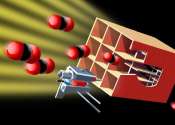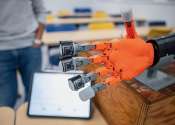Last update:
Engineering news

Finger wrap uses sweat to provide health monitoring at your fingertips
A sweat-powered wearable has the potential to make continuous, personalized health monitoring as effortless as wearing a Band-Aid. Engineers at the University of California San Diego have developed an electronic finger wrap ...
Engineering
8 hours ago
0
34

Researchers develop mobile test platform for offshore wind turbines
Public power grids are highly complex systems. Wind turbine manufacturers have to comply with technical guidelines when connecting new turbines to avoid putting grid stability at risk. In the Mobil-Grid-CoP project, researchers ...
Engineering
21 hours ago
0
1

Researchers develop neural network algorithm to enhance gas detection technology
Tunable diode laser absorption spectroscopy (TDLAS) technology holds significant potential for greenhouse gas detection, due to its advantages of non-contact, real-time measurements. However, the technical bottleneck of cross-interference ...
Engineering
Sep 2, 2024
0
27

Aluminum foil that can clean water—researchers develop coating that attracts and traps dangerous microbes
More than 2 billion people around the world do not have access to safe, uncontaminated drinking water. Around 418 million of them live in African countries.
Engineering
Sep 2, 2024
0
1

Double-helical design boosts concrete crack resistance
Taking inspiration from nature, researchers from Princeton Engineering have improved crack resistance in concrete components by coupling architected designs with additive manufacturing processes and industrial robots that ...
Engineering
Sep 2, 2024
0
15

Scientists develop new structure to control vibration of machines and instruments
Scientists say they have developed a structure that can absorb and reduce vibrations of engineering and mechanical gadgets more effectively than conventional systems hitherto used to contain the trembling of machines and ...
Engineering
Sep 2, 2024
0
3

Engineering approach can improve stability of perovskite solar cells under reverse bias conditions
Solar cells based on perovskites, a versatile class of materials with promising optoelectronic properties, are gradually making their way toward commercialization. While these solar cells can have notable advantages over ...

Robot waiters in Kenya create a buzz. But there are concerns about what it means for human labor
Children giggle as young people flash their smartphones to film robots carrying plates of freshly prepared meals on their inbuilt trays to deliver to diners in a busy eatery in Kenya's capital.
Robotics
Sep 1, 2024
0
7

Seeing the invisible: How X-ray reveals spatter behavior during 3D printing
Research conducted by UCL researchers reveals and explains the links between vapor depression shape and spatter dynamics during LPBF under various industry-relevant processing conditions.
Engineering
Aug 30, 2024
0
1

Researchers develop ultra-high efficiency perovskite LEDs by strengthening lattice
A research team has developed ultra-high efficiency perovskite nanocrystal light-emitting diodes (LEDs) by strengthening the perovskite lattice and suppressing the material's inherent low-frequency dynamics.
Engineering
Aug 30, 2024
0
47

Developing underwater robots to venture deep below polar ice
On a remote patch of the windy, frozen Beaufort Sea north of Alaska, engineers from NASA's Jet Propulsion Laboratory in Southern California huddled together, peering down a narrow hole in a thick layer of sea ice. Below them, ...
Robotics
Aug 29, 2024
0
3

Researchers innovate optical microchips with applications for sensing and communications
Infrared light cannot be seen, but it can be felt as heat. Lying beyond the red color in the electromagnetic spectrum, it is used by animals to detect prey in the dark and in night vision cameras.
Engineering
Aug 29, 2024
0
1

How low can we go? Radical change is needed to cut the carbon that goes into buildings to net zero, say researchers
Buildings are one of our biggest contributors to global heating. They produce 37% of all greenhouse gas emissions from energy use and production processes. Building emissions are made up of two parts: operational carbon (from ...
Engineering
Aug 29, 2024
0
7

Scientists develop eco-friendly microfabrication method using water and paper
Imagine being able to create incredibly tiny structures with the same ease and sustainability as printing on paper. This is the frontier of microfabrication—the process of making microscopic structures that are crucial ...
Engineering
Aug 29, 2024
0
84

Biohybrid robots controlled by electrical impulses in mushrooms
Building a robot takes time, technical skill, the right materials—and sometimes, a little fungus.
Robotics
Aug 28, 2024
0
92

Thermochromic material could make indoor temperature control more energy-efficient
Rice University researchers have developed a smart material that adjusts its transparency with changes in temperature, outperforming similar materials in terms of durability, transparency and responsiveness. The new polymer ...
Engineering
Aug 28, 2024
0
58

New manufacturing processes allow adhesive-free joining of wood and metal
Using 3D printing technology and ultrasonic joining techniques, researchers at TU Graz have succeeded in attaining an extremely strong joining of a renewable raw material wood with metal and polymer composite.
Engineering
Aug 28, 2024
0
18

Researchers develop a new humanoid platform for robotics research
Advancements in the field of robotics are fueled by research, which in turn heavily relies on effective platforms to test algorithms for robot control and navigation. While numerous robotics platforms have been developed ...

Metal baseball bats still help Little Leaguers hit a little better
While meant to simulate wood bats, regulation USA Baseball metal bats are more forgiving than wood for young players who might not connect with the ball on a bat's optimal "sweet spot."
Engineering
Aug 27, 2024
0
1

New air-based refrigeration system developed to replace harmful refrigerants
The Korea Institute of Energy Research (KIER) has developed, for the first time in the country, a refrigeration technology that uses air as a refrigerant instead of Freon gas, hydrofluorocarbons (HFCs), and other refrigerants ...
Engineering
Aug 27, 2024
0
30
Other news

Unveiling the molecular mechanisms linking aging with neurodegenerative diseases

The Martian polar caps are not created equally—here's why

Kākāpō, not kiwi, are the true ancient species of Aotearoa, say paleontologists

Tropical plants discovered in Tasmania's ancient Polar Forest

Mexican bat found to have photoluminescent feet

Hawk defies expectations in the face of habitat decline































































